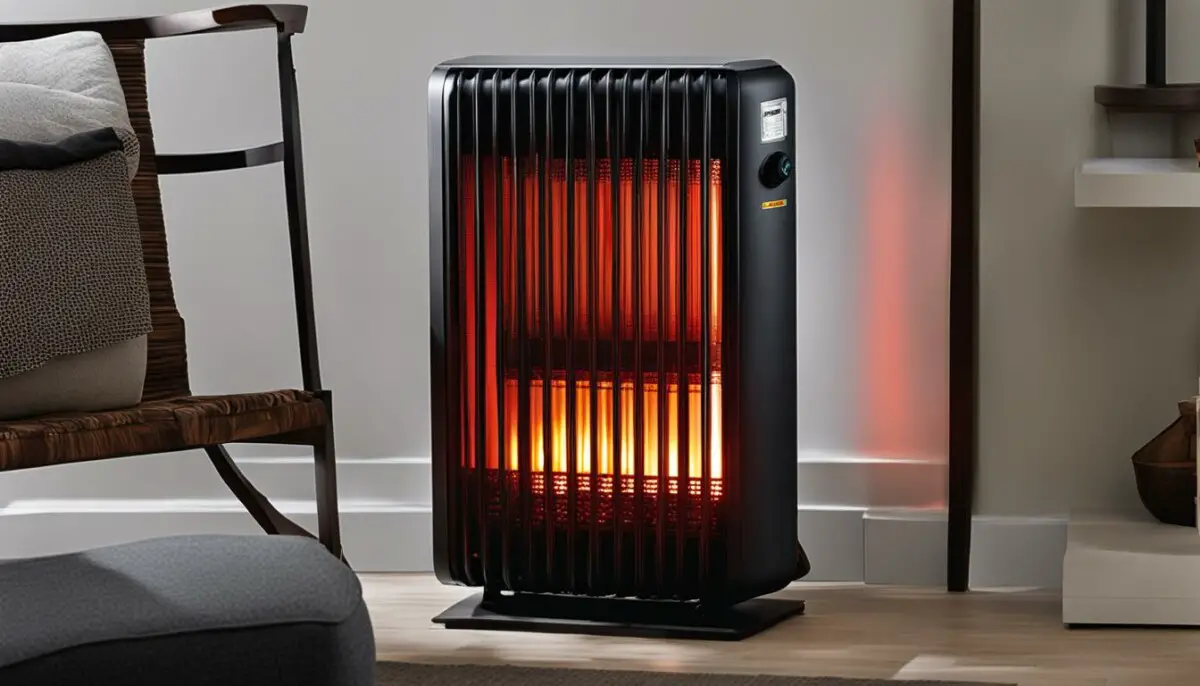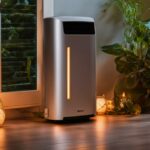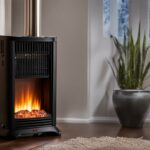Last Updated on 4 months by Francis
Welcome to our article on the safety of non vented natural gas infrared heaters. These heaters offer efficient heating solutions for spaces without traditional ventilation systems. However, it’s important to understand the potential risks and hazards associated with their use. In this article, we will explore the safety concerns surrounding non vented gas heaters and provide valuable insights to help you make informed decisions.
Contents
Key Takeaways:
- Non vented gas heaters release combustion products into the heated room, which can worsen indoor air pollution.
- While equipped with an oxygen depletion sensor, concerns still exist regarding the safety of these heaters.
- Understanding how non vented gas heaters work can help mitigate potential risks.
- There are different types of non vented gas heaters available, catering to various heating needs.
- Evaluating the efficiency and heat distribution of non vented gas heaters is crucial before making a purchase.
How Non Vented Gas Heaters Work
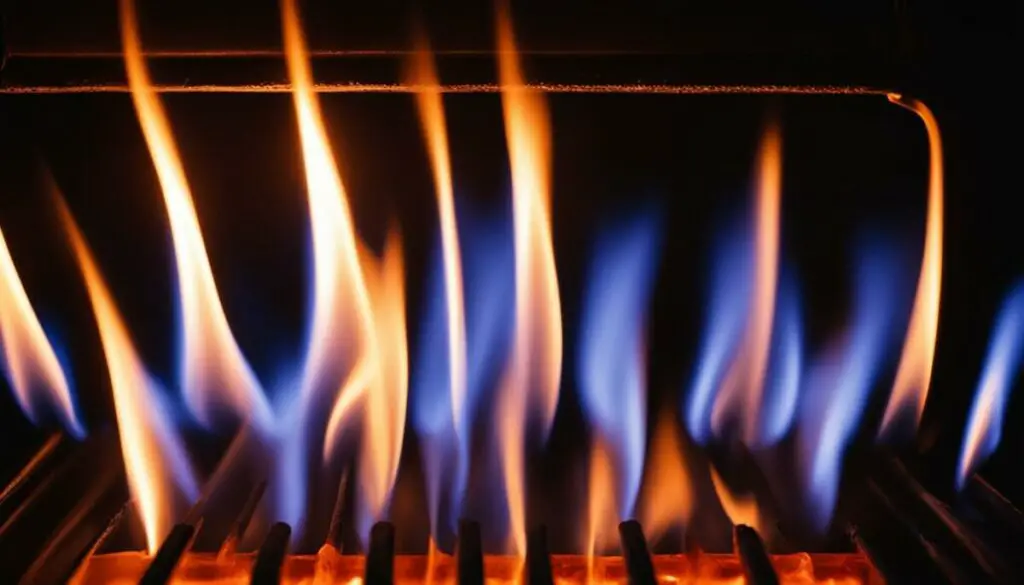
Non vented gas heaters rely on the available oxygen in the room for combustion. They release water vapor and carbon dioxide into the room as by-products. While the combustion process is efficient, it can still produce small amounts of carbon monoxide, nitrogen dioxide, and unburned hydrocarbons. The oxygen depletion sensor helps monitor oxygen levels in the room to ensure safety.
When non vented gas heaters are turned on, they draw in air from the room and use it as fuel for the combustion process. The gas burner ignites the fuel and releases heat, which warms the room. During this combustion process, water vapor and carbon dioxide are produced as natural by-products.
Although non vented gas heaters are designed to operate efficiently, there is still a potential for the production of various harmful gases, including carbon monoxide and nitrogen dioxide. Carbon monoxide is particularly concerning as it is odorless and can lead to carbon monoxide poisoning if inhaled in high concentrations.
To ensure the safety of occupants, these heaters are equipped with an oxygen depletion sensor (ODS) that constantly monitors the oxygen levels in the room. If the sensor detects a decrease in oxygen, it automatically shuts down the heater to prevent oxygen depletion and the build-up of harmful gases.
The combustion process of non vented gas heaters can also release small amounts of unburned hydrocarbons. These hydrocarbons contribute to the overall air pollution in the room.
Types of Non Vented Gas Heaters
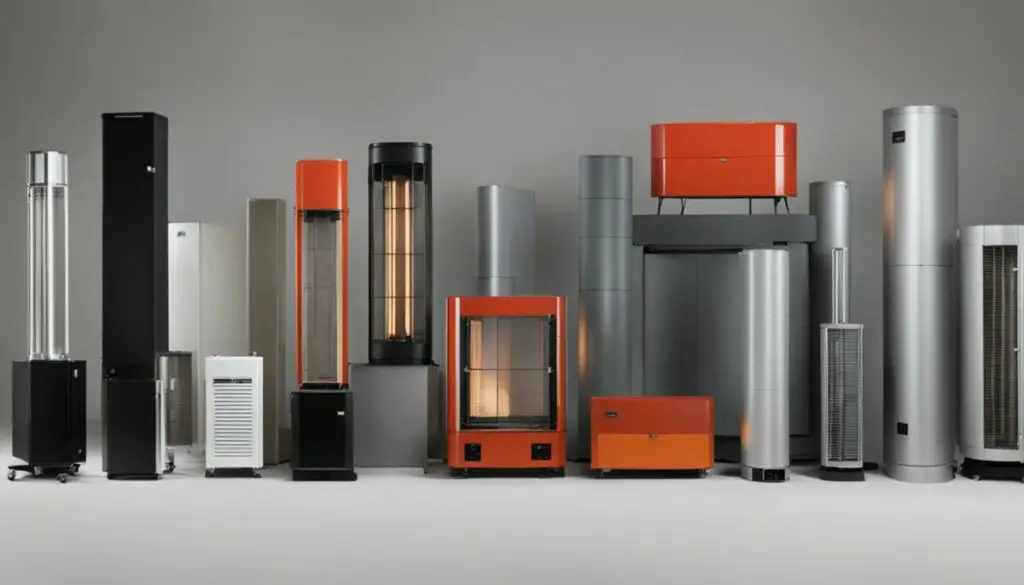
Non vented gas heaters offer a variety of options to suit different heating needs. From small and portable devices to larger units designed for permanent heat sources, there is a range of choices available. These heaters come in various sizes, flame patterns, and features, providing versatility and flexibility in heating solutions.
Small and Portable Devices
For those seeking heating options for a single room or smaller space, small and portable non vented gas heaters are an ideal choice. These compact units offer convenience and flexibility, allowing you to easily move them around as needed. Whether you’re looking to heat a bedroom, office, or any other small area, these devices provide efficient heating without the need for ventilation.
Larger Units for Permanent Heat Sources
If you’re in need of heating solutions for larger spaces or multiple rooms, larger non vented gas heaters are available. These units are designed to provide consistent and effective heat distribution throughout an entire area. By utilizing additional blower kits and ducting, these heaters can effectively heat multiple spaces, making them a suitable option for homes, commercial buildings, or any other location requiring comprehensive heating.
Various Flame Patterns and Sizes
Non vented gas heaters offer an array of flame patterns to suit different preferences and aesthetics. Whether you prefer the elegant blue flame, the focused warmth of infrared, or the cozy ambiance of a yellow flame, there is a flame pattern to complement your desired atmosphere. Additionally, these heaters come in a range of sizes, catering to different heating needs. From smaller units with a heating capacity of less than 5,000 Btu/hour to larger models exceeding 38,000 Btu/hour, there is a size suitable for every space.
| Heater Type | Flame Pattern | Heating Capacity (Btu/hour) |
|---|---|---|
| Small and Portable Devices | Various options | Less than 5,000 |
| Larger Units for Permanent Heat Sources | Various options | More than 38,000 |
Note: The table above provides an overview of the different types of non vented gas heaters, their flame patterns, and heating capacities. Please consult the manufacturer’s specifications for precise details on individual models.
With the wide range of options available, you can find the perfect non vented gas heater to suit your specific heating needs. Whether you require a small and portable device or a larger unit for permanent heat sources, these heaters offer efficient and effective heating solutions.
The Efficiency of Non Vented Gas Heaters
Non vented gas heaters are highly efficient in quickly heating a space. Their combustion process generates heat that warms the room effectively, allowing you to feel the warmth almost instantly. However, it’s important to note that not all of the heat produced by these heaters is distributed evenly throughout the space.
The emitted heat from a non vented gas heater tends to rise and may accumulate near the ceiling. This can result in uneven heat distribution, with the upper areas of the room being warmer than the lower regions. To overcome this, it’s advisable to use ceiling fans or other means of air circulation to help distribute the heat more effectively.
Water Vapor Condensation
One byproduct of the combustion process in non vented gas heaters is water vapor. While this adds moisture to the air, it also has the potential to condense on interior surfaces if not properly managed. Excessive condensation can lead to various issues, such as:
- Wood rot
- Peeling paint
- Mold growth
To prevent these problems, it’s essential to maintain proper ventilation in the room. This helps to control the humidity level and minimize condensation. Additionally, regularly monitoring and managing the moisture levels in the room can help mitigate the risks associated with water vapor condensation.
| Advantages of Non Vented Gas Heaters | Disadvantages of Non Vented Gas Heaters |
|---|---|
|
|
While non vented gas heaters offer efficient heating, it’s crucial to consider their limitations, such as the possibility of uneven heat distribution and the need for proper ventilation to manage water vapor condensation. By understanding and addressing these factors, you can make informed decisions about using non vented gas heaters in your space.
Potential Toxic By-Products of Non Vented Gas Heaters
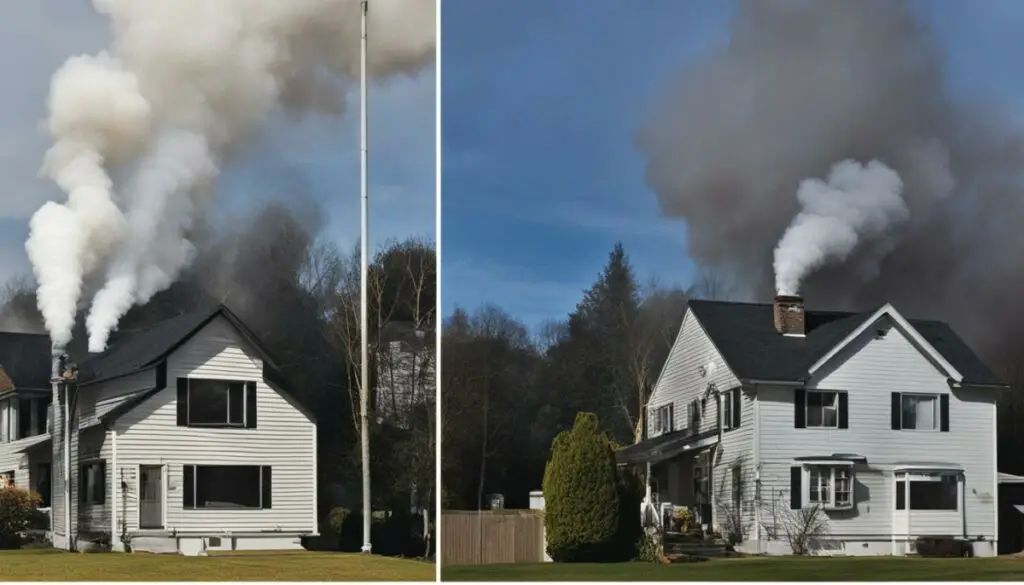
Non vented gas heaters can produce toxic by-products that can have detrimental effects on indoor air quality. These by-products include carbon monoxide, carbon dioxide, nitrogen dioxide, and water vapor. It is important to be aware of the potential health risks associated with these substances.
Carbon Monoxide
Carbon monoxide is a colorless and odorless gas that is produced when natural gas or propane is burned. High concentrations of carbon monoxide can be extremely dangerous, leading to carbon monoxide poisoning. Symptoms of carbon monoxide poisoning can include headaches, dizziness, nausea, confusion, and in severe cases, unconsciousness or death. It is crucial to have proper ventilation and carbon monoxide detectors in place to detect and mitigate the presence of this toxic gas.
Nitrogen Dioxide
Non vented gas heaters can also release nitrogen dioxide, a harmful gas that can irritate the respiratory system. Prolonged exposure to nitrogen dioxide can contribute to respiratory issues, particularly in individuals with asthma or other pre-existing respiratory conditions. Symptoms of nitrogen dioxide exposure may include coughing, wheezing, chest tightness, and shortness of breath. Ensuring proper ventilation is essential to minimize the release and accumulation of nitrogen dioxide in indoor spaces.
Water Vapor
While water vapor is not a toxic gas, high levels of moisture in the air can lead to various issues such as mold growth and other moisture-related problems. Non vented gas heaters release water vapor as a by-product of combustion, and if not properly managed, excessive moisture can result in the growth of mold, mildew, and bacteria. These allergens can negatively impact indoor air quality and pose potential health risks, especially for individuals with respiratory sensitivities or compromised immune systems.
To ensure the safety and well-being of occupants, it is crucial to address the potential toxic by-products of non vented gas heaters. Proper ventilation, regular maintenance, and the use of carbon monoxide detectors can help minimize the risks associated with carbon monoxide and other harmful substances. It is also important to follow manufacturer guidelines and exercise caution when using these heaters.
For a visual representation of the potential toxic by-products produced by non vented gas heaters, refer to the table below:
| Gas By-Product | Properties | Effects on Health |
|---|---|---|
| Carbon Monoxide (CO) | Colorless, odorless gas | Poisonous at high concentrations, can cause carbon monoxide poisoning |
| Nitrogen Dioxide (NO2) | Reddish-brown gas with a pungent odor | Irritates the respiratory system, can worsen asthma symptoms |
| Water Vapor (H2O) | Gaseous state of water | High levels can contribute to mold growth and other moisture-related issues |
Visual representation of the potential toxic by-products produced by non vented gas heaters:
Safety Concerns with Non Vented Gas Heaters

When it comes to using non vented gas heaters, it’s important to prioritize safety and be aware of the potential health risks involved. These heaters can pose dangers if not used properly and precautions are not taken. Here are some important safety considerations to keep in mind:
- Proper Ventilation: Ensuring adequate ventilation is crucial when operating non vented gas heaters. These heaters release combustion by-products, including carbon monoxide and nitrogen dioxide, into the room. To prevent the build-up of these harmful gases, it’s recommended to open a window or door to allow fresh air circulation. This helps maintain oxygen levels and reduce the risk of oxygen depletion.
- Time Limits for Operation: Safety guidelines typically recommend limiting the operation time of non vented gas heaters. This is because continuous operation can lead to the accumulation of combustion by-products. It’s important to follow the manufacturer’s instructions and avoid using these heaters as the primary source of heating for extended periods.
- Carbon Monoxide Detectors: Installing carbon monoxide detectors is essential for early detection of this highly poisonous gas. These detectors can alert you if carbon monoxide levels in the room become dangerously high. Place them near sleeping areas and ensure they are tested regularly to maintain their effectiveness.
- Regular Maintenance: Proper maintenance of non vented gas heaters is crucial to ensure their safe operation. Regularly clean the heater and inspect it for any signs of damage or malfunction. Schedule professional maintenance checks to ensure the unit is functioning properly and to identify any potential safety hazards.
“The proper use and maintenance of non vented gas heaters is essential for the safety and well-being of household members. It’s important to understand the potential health risks and take necessary precautions to mitigate them.” – HVAC expert
By following these safety precautions and ensuring proper ventilation, you can enjoy the warmth and comfort of non vented gas heaters while minimizing health risks. Remember, your safety and the safety of your loved ones should always be a top priority when using any type of heating device.
The Dangers of Carbon Monoxide (CO)
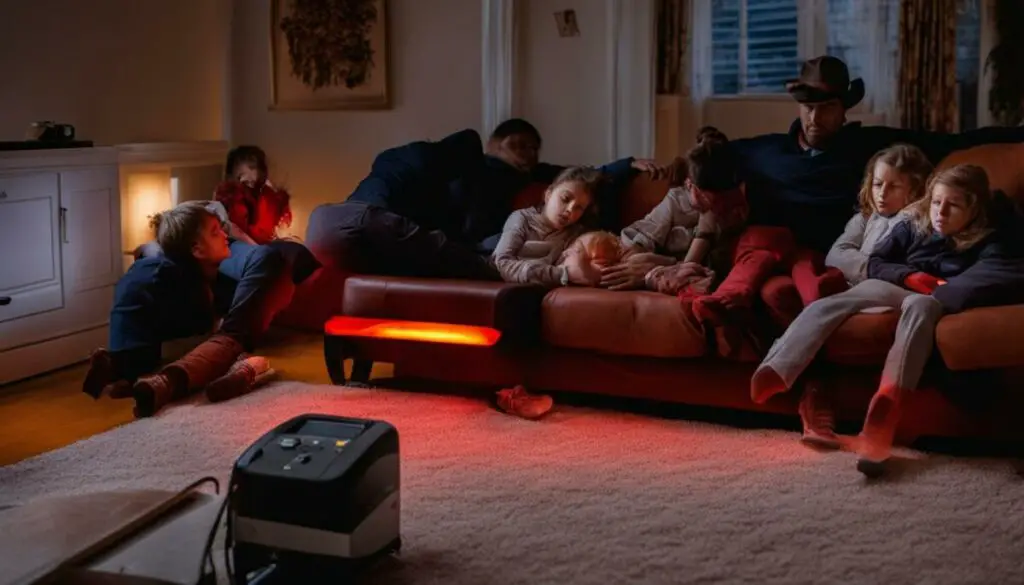
Carbon monoxide poisoning is a grave concern when it comes to non-vented gas heaters. This highly poisonous gas is produced by the incomplete combustion of carbon-based fuels. When non-vented gas heaters are not properly maintained and regulated, they can emit carbon monoxide, posing serious health risks to individuals in the vicinity.
Exposure to carbon monoxide can have severe consequences, including the potential for death or lasting damage to the brain and vital organs. Carbon monoxide binds to the hemoglobin in our blood, reducing its ability to transport oxygen throughout the body. Lack of oxygen can lead to dizziness, confusion, loss of consciousness, and even fatality.
Therefore, it is crucial to adopt safety measures to protect against carbon monoxide poisoning. One key safety measure involves ensuring proper ventilation in the space where the non-vented gas heater is being used. Adequate ventilation helps to dissipate any carbon monoxide that may be released, reducing the risk of accumulation.
Equally important is the installation of carbon monoxide detectors. These devices can provide an early warning in the event of elevated carbon monoxide levels, allowing occupants to evacuate the area promptly and seek medical attention. Carbon monoxide detectors should be positioned according to the manufacturer’s instructions, which often recommend placement near sleeping areas and on every level of the home.
By implementing these safety measures, individuals can significantly reduce the risks associated with carbon monoxide and enjoy the comfort of their non-vented gas heaters with peace of mind.
“It is crucial to adopt safety measures to protect against carbon monoxide poisoning.”
Health Risks Associated with Carbon Monoxide Poisoning:
- Headaches
- Nausea
- Dizziness
- Fatigue
- Confusion
- Shortness of breath
| Severity of Symptoms | Carbon Monoxide Concentration in PPM (parts per million) |
|---|---|
| None | 0-9 |
| Mild | 10-35 |
| Moderate | 36-99 |
| High | 100-199 |
| Very high | 200+ |
The Dangers of Carbon Dioxide (CO2)
Carbon dioxide levels, although not as toxic as carbon monoxide, can have negative effects on health when present in high quantities. Too much carbon dioxide in closed buildings can cause symptoms such as fatigue, headaches, and a feeling of stuffiness. It is important to be aware that non vented gas heaters can release significant amounts of carbon dioxide into the room, which can be detrimental to your well-being.
One effective way to mitigate the risks associated with high carbon dioxide levels is through adequate ventilation. Proper ventilation ensures the circulation of fresh air, preventing the accumulation of carbon dioxide in enclosed spaces. It is recommended to open windows or use mechanical ventilation systems to promote air exchange and maintain healthy indoor air quality.
Understanding the risks of carbon dioxide and prioritizing ventilation can help safeguard your health and create a safe environment when using non vented gas heaters.
The Dangers of Nitrogen Dioxide (NO2)
Non vented gas heaters can produce nitrogen dioxide, which is a harmful gas that can cause respiratory irritation. Even at low concentrations, nitrogen dioxide can lead to coughing, sore throat, headache, dizziness, and nausea. Individuals with pre-existing respiratory conditions, such as asthma, may be more susceptible to the effects of nitrogen dioxide.
If not properly ventilated, nitrogen dioxide exposure from non vented gas heaters can contribute to the development or exacerbation of respiratory conditions, including asthma. Studies have shown a correlation between nitrogen dioxide exposure and increased asthma attacks in both children and adults.
Asthma attacks triggered by nitrogen dioxide can range from mild symptoms, such as wheezing and shortness of breath, to more severe respiratory distress requiring medical intervention. It is essential to minimize exposure to nitrogen dioxide to protect the respiratory health of individuals, especially those with pre-existing conditions.
“Nitrogen dioxide exposure from non vented gas heaters can contribute to respiratory irritation and asthma attacks. By minimizing exposure and ensuring proper ventilation, individuals can protect their respiratory health.”
To reduce the risks associated with nitrogen dioxide exposure, it is crucial to ensure proper ventilation when using non vented gas heaters. Opening windows or using a mechanical ventilation system can help remove the harmful gases and maintain healthier indoor air quality. Regularly servicing and maintaining the gas heater can also help prevent the release of excessive nitrogen dioxide.
Individuals with asthma or other respiratory conditions should take extra precautions when using non vented gas heaters. It is advisable to consult with a medical professional regarding the safest heating options for their specific needs. Taking these steps can help mitigate the respiratory risks associated with nitrogen dioxide exposure from non vented gas heaters.
Comparison of Nitrogen Dioxide Emission Levels
| Heater Brand | Average Nitrogen Dioxide Emission (ppm) |
|---|---|
| Brand A | 5.65 |
| Brand B | 3.92 |
| Brand C | 8.21 |
The table above provides a comparison of nitrogen dioxide emission levels for different non vented gas heater brands. It is essential to consider the emission levels when choosing a gas heater to minimize potential exposure to harmful gases.
Conclusion
Non vented gas heaters can provide efficient heating solutions for your home, but it’s crucial to prioritize safety to protect the health and well-being of your household. Understanding the potential hazards associated with these heaters is the first step towards safe usage.
By following proper usage guidelines and safety precautions, you can minimize the risks associated with non vented gas heaters. Ensure that the room is adequately ventilated to prevent the build-up of harmful by-products like carbon monoxide and carbon dioxide. Opening a window or using a fan can help maintain fresh air circulation.
Additionally, it’s important to schedule regular maintenance and inspections for your non vented gas heater to ensure it is working efficiently and not emitting high levels of toxic gases. Consider installing carbon monoxide detectors in your home for early detection of any potential leaks.
Remember, the safety of your loved ones should be your utmost priority. By being mindful of the safety precautions and proper usage of non vented gas heaters, you can enjoy the warmth and comfort they provide without compromising your well-being.
FAQ
Are non vented natural gas infrared heaters dangerous?
While non vented natural gas infrared heaters can be efficient in heating spaces, there are safety concerns associated with them. These heaters release combustion by-products into the room, including carbon monoxide and nitrogen dioxide, which can be harmful if not properly ventilated. It is important to understand the risks and follow safety precautions when using these heaters.
What are the dangers of non vented natural gas infrared heaters?
Non vented natural gas infrared heaters can pose several risks. They can release toxic by-products such as carbon monoxide and nitrogen dioxide, which can cause health problems. In addition, these heaters can produce excessive water vapor, leading to issues like mold growth. Proper ventilation and safety precautions are essential to mitigate these dangers.
What safety concerns should I be aware of with non vented natural gas infrared heaters?
When using non vented natural gas infrared heaters, it is crucial to prioritize safety. Proper ventilation is necessary to prevent the build-up of harmful by-products. It is also important to follow safety precautions such as opening a window for fresh air circulation and using these heaters within recommended time limits. These measures help ensure the safety and well-being of household members.
What are the potential hazards of non vented natural gas infrared heaters?
Non vented natural gas infrared heaters can pose hazards if not used correctly. They can emit carbon monoxide, a highly poisonous gas that can cause death or lasting damage to the brain and organs. High levels of carbon dioxide, another by-product, can cause fatigue, headaches, and a feeling of stuffiness in closed buildings. Additionally, nitrogen dioxide, released by these heaters, can irritate the respiratory system and contribute to respiratory problems.
What are the health risks associated with non vented natural gas infrared heaters?
Non vented natural gas infrared heaters can produce toxic by-products such as carbon monoxide and nitrogen dioxide. Carbon monoxide is particularly dangerous at high concentrations and can cause health problems. Nitrogen dioxide can irritate the respiratory system and contribute to asthma attacks. It is important to ensure proper ventilation and follow safety precautions to minimize these health risks.
What safety precautions should I take when using non vented natural gas infrared heaters?
To safely use non vented natural gas infrared heaters, it is important to prioritize proper ventilation. Opening a window to allow fresh air circulation can help prevent oxygen depletion and the accumulation of harmful by-products. It is also recommended to use these heaters within recommended time limits and avoid relying on them as the primary heating source. Additionally, installing carbon monoxide detectors in the area can provide an added layer of safety.
Why is proper ventilation important for non vented natural gas infrared heaters?
Proper ventilation is crucial for non vented natural gas infrared heaters to avoid the build-up of harmful by-products. These heaters release combustion by-products, including carbon monoxide and nitrogen dioxide, which can be dangerous if not properly ventilated. Adequate ventilation ensures the safe operation of these heaters and helps maintain good indoor air quality.
What are the risks of non vented natural gas infrared heaters?
Non vented natural gas infrared heaters can pose several risks if not used correctly. They can emit carbon monoxide, a toxic gas, and release nitrogen dioxide, which can cause respiratory irritation. Additionally, the combustion process of these heaters produces water vapor that can lead to issues such as mold growth and moisture-related damage. Understanding these risks and taking necessary safety precautions is crucial for safe usage of these heaters.

